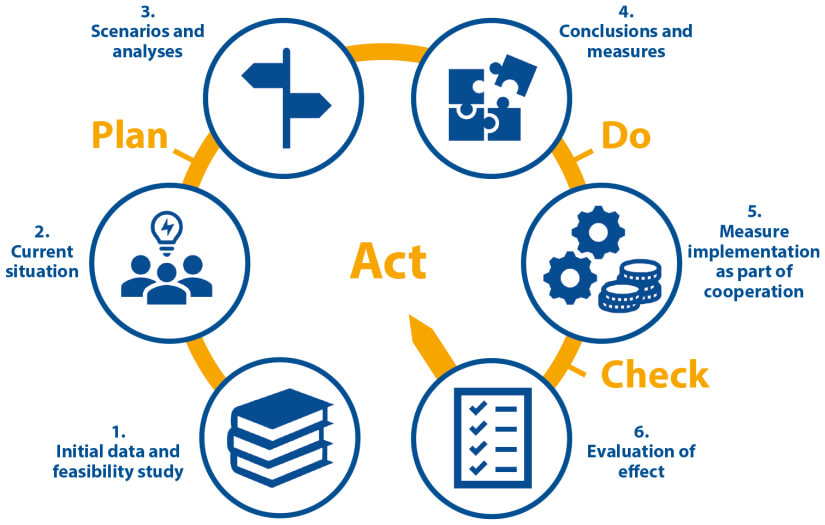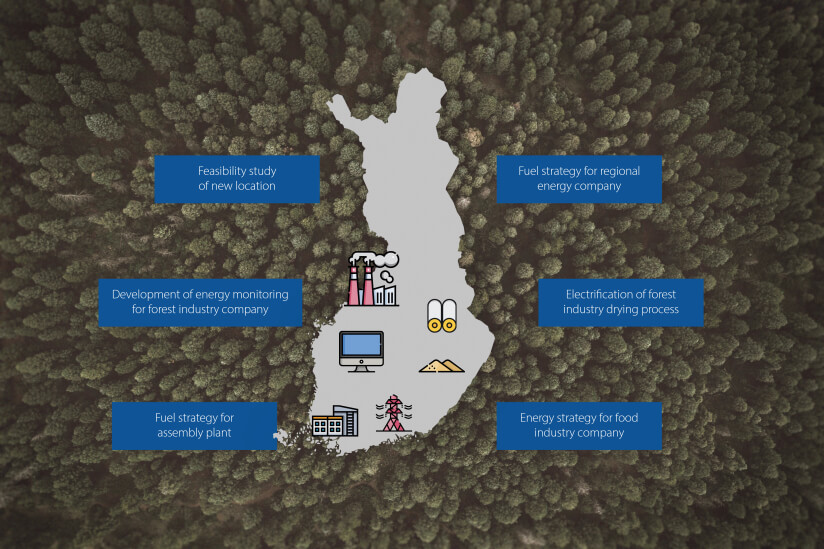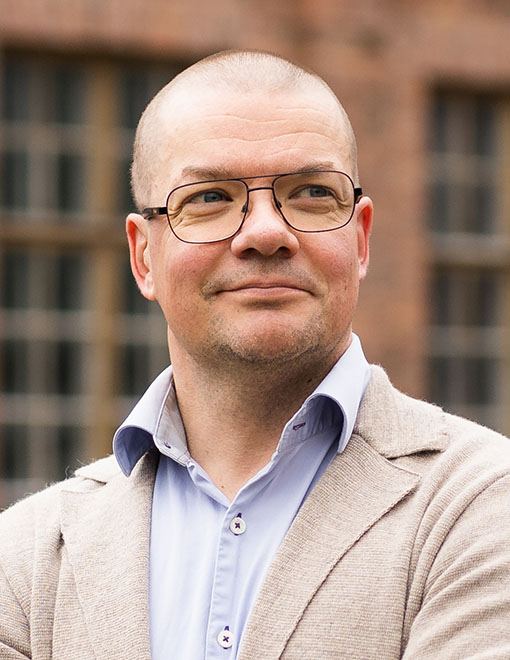14/01/2021
Tool for developing the operations of industry and energy companies — Managing the energy future™
The energy market is currently experiencing a major transformation that will have a significant impact on both the energy industry and industrial business operations in the future. In the future, an industrial operator may be a producer of electricity and heat and, correspondingly, an energy company can be a major player in the circular economy. In addition, cooperation with different actors will become more pronounced. Although it will be a big challenge for everyone, it is possible to respond with a systematic approach.
A crisis can be an opportunity
At the time of writing, we are living in autumn 2020 and surviving the first wave of COVID-19, and the supposed second wave is currently reaching Finland. Although there are dark clouds in the sky for Finnish industry, COVID-19 has not, at least so far, changed the prevailing megatrends. Climate change and the quest for carbon neutrality are still here. Throughout history, crises have created space for something new and have contributed to accelerating development. For example, all the conditions for effective remote work have been available for some years, but now, thanks to the crisis, we took a huge leap in just a few months.
Examining the current situation in the industrial and the energy sector, it is likely that, in the post-crisis world, energy prices, carbon neutrality and the functioning of energy supply will be key sustaining factors. Energy security will also be one of the key factors in maintaining social peace.
The ongoing development is also likely to be boosted by COVID-19-related economic recovery measures. Directing these recovery measures towards the so-called green recovery, is much talked about at the EU level. This would fit in well with the EU’s pre-COVID-19 Green Deal programme, which aims to allocate a total of EUR 750 billion by 2027 to projects aimed at the efficient use of resources, a clean circular economy, emission reduction, or biodiversity conservation. The energy sector will be a key player in promoting these projects, but industry will also play an important role. The background to this work is the very ambitious carbon neutrality targets set by the EU for 2030, and in the long term, for 2050.
Sector integration is a key tool on the road to carbon neutrality
In 2020, the EU published a so-called sector integration strategy, which is one of the key tools in the fight against climate change. Sector integration describes the cooperation between different energy systems, technologies and carriers. It aims to reduce emissions in a wide range of sectors of the economy in a cost-effective manner and to enable renewable forms of electricity production to be integrated into the energy system without problems for the security of supply.
In practice, this means that the activities of energy companies, industry, and different service providers, for example, are converging, making it possible to find new and effective tools for climate work. This, of course, opens up completely new business opportunities and possibly also disrupts the traditional approach in different industries. In the future, an energy company can be a major circular economy operator or, for example, a technology supplier in heat recovery solutions. On the other hand, in the future, an industrial operator can generate heat for the municipal district heating network, trade electricity in the reserve market and be part of an industrial park’s resource pool. Properties and consumers also have their own role. Depending on the situation, properties may be both energy producers and cooling system users. Consumer data will also play an increasingly important role as energy networks are driven more comprehensively and efficiently.
Managing the energy future – what is it?
The energy future is a very new concept and there is no unambiguous definition of it. However, it can be seen as a future space for energy production, distribution and use, where a significant part of energy is increasingly produced, used more efficiently and recycled in an increasingly holistic way. There are several factors influencing this development and if you look at it from the point of view of industry and energy companies, the following influential themes are:
- Global megatrends
- Energy policy and its predictability
- Social change and changes in consumption habits
- Change in energy business models and financing needs
- Decentralisation of energy production and new forms of energy production
- Electrification of society
- Threats and opportunities of the data economy
- Ensuring critical resources and skills
- Energy efficiency
- Demand response
- Industrial circular economy and carbon neutrality
The aforementioned list points to a challenging and complex issue. When an entity of this scale needs to be managed in a controlled manner, it is easy to understand that without a systematic approach, as well as extensive cooperation and know-how, the task would easily become impossible.
How can the energy future be managed?
Therefore, the objective of managing the energy future is to form an individual development path for each company and to start implementing it purposefully. It is essential that the actions are extended to daily operations, with a Plan-Do-Check-Act operating model, familiar in the corporate world in the management of operations (See Diagram 1).

When you look at the big picture from the point of view of an energy company or a production plant, you can start to work together on the definition and management of the future model using a three-step operating model (See Diagram 2).

Current status of company
- History
- KPI metrics
- Organisation
- Established operating models and processes
- Production machinery
- Distribution networks
- Customers
- Partners
- Contract management
- Procurement of raw materials
- Competitors
- Environment (physical and mental)
- OUTPUT: Current status description report

Creating and maintaining future vision
- Maintaining / increasing market position
- Production cost management
- Boundary conditions and restrictions for business
- Necessary resources and measures
- Timetables
- OUTPUT: Creating and maintaining alternatives and scenarios

Implementation phase
- Implementation, start-up and change support
- Workshops according to the annual clock
- Interviews with different functions
- Management Team Advisor
- OUTPUT: Concrete development activities and return expectations
The first step is to define the current state providing a realistic picture of the present condition of the company’s business. The next step is to create a vision for the future and possible scenarios. It is essential to identify opportunities and risks at this stage. At the end of the scenario task, the company’s future objectives and measures (strategy) are created to achieve the objectives. Then we move on to the operational step, which includes taking concrete actions towards the vision of the future. The final step is the impact assessment (act) also used in corporate management, which verifies the effects and determines the necessary corrective measures.
Energy needs to be more efficiently produced, used, and recycled in a holistic way.
Concrete approach leads to results
Creating a future vision and forming a scenario always begins with a comprehensive study of the baseline. In practice, the issues to be reviewed vary as to whether it is an energy company or an industrial operator, but the issues important for an industrial company, for example, are at least the following:
- Energy consumption data and prices, by energy fraction
- Energy balances
- Energy efficiency activities
- Future plans and investments with an impact on future energy use
- Fuels used, their availability, price development, etc.
- Documentation of the most significant energy uses/processes
- Documentation of factory area transmission networks
The gathered information is specified with fieldwork, where interviews and scenario workshops are conducted as part of getting to know the site’s activities. The aim is to have the widest possible representation at the workshops, in order to consider the perspectives of the various activities.
The information gathered is then analysed in relation to development trends at the societal and global levels. A scenario of the energy use of the operations is produced, strategic goals/measures related to energy use are formed, and a concrete list of measures is defined. Typical measures may include:
- Development of energy efficiency activities
- Alternative fuels towards carbon neutrality
- Utilisation of heat pumps as part of heating and cooling
- Investment in energy storage capacity
- Development needs of transmission networks
- Development of communications related to energy issues
After the analysis, the measures are summarised in two parts: an extensive technical report and a summary for management use. The broader part of the report includes comprehensive descriptions of operations, techno-economic reviews, CO2 calculations, concrete recommendations for action, and the necessary energy scenarios. In many cases, an essential part of the work is also creating future development paths, political priorities and estimates of the future price development of energy fractions and technologies.
Summary
Energy will continue to be one of the most important factors in maintaining social peace. At the same time, it should be produced more cleanly and efficiently. The challenge will affect our entire society, and there are not many individual “easy” solutions. In order to make the foggy future even a little clearer now, it is important to start systematically forming an understanding of the situation and implementing the identified measures consistently.
Applying the operating model to different needs
The approach presented in this article can be applied to very different needs. Figure 1 shows our recent customer relationships on energy future topics.
As noted, before, the energy future is broadly relevant to energy companies as well as industry, and the developed operating model can be applied to different needs. The most extensive cooperation models have been the formation of an energy strategy for an entire plant, which has delved into the area’s availability of electricity, CO2-free heat production, and the development of energy efficient operations in the area. Correspondingly, an example of an operating model for energy companies is the implementation of a fuel strategy for a regional energy company. The work examined the current state of fuel use and formed a view of the future, how the company will be able to meet future challenges and changes in the field of operation.
Some of the cooperation projects have been very specific, such as focusing on electrifying an energy-intensive process or consulting on the location of a plant, taking into account the energy infrastructure and consumables available in the area.
Energy will continue to be one of the most important factors in maintaining social peace. At the same time, it should be produced more cleanly and efficiently. The challenge will affect our entire society, and there are not many individual “easy” solutions. In order to make the foggy future even a little clearer now, it is important to start systematically forming an understanding of the situation and implementing the identified measures consistently.


